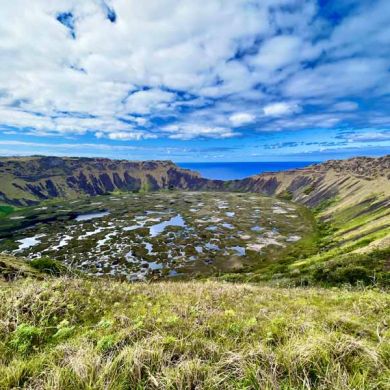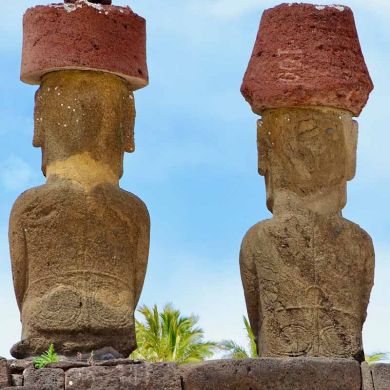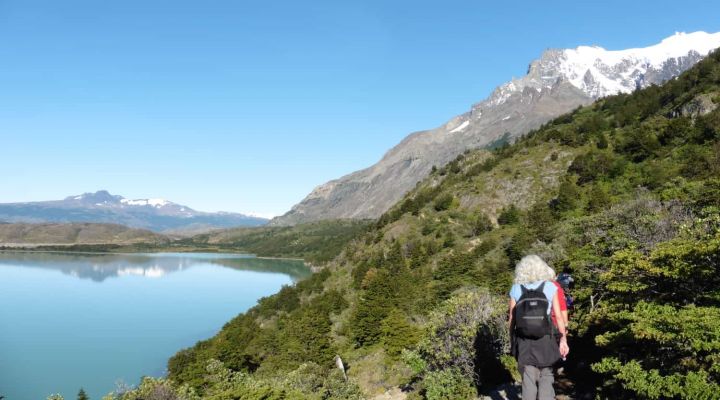Easter Island Extension
Trip Overview
This 5-day extension tour to Easter Island, also known as Rapa Nui, explores the many fascinating archaeological sites on the island.
Easter Island, which is part of Chile, is a remote volcanic island located in the Pacific Ocean 2,200 miles (3,600 km) away from mainland Chile. The island is well-known for its archaeological sites, including nearly 900 stone statues (called Moai) scattered across the island, that were carved by the inhabitants from as far back as the 13th century.
During this extension, you will learn about the history, culture and traditions of the Rapa Nui people, as well as soak in the natural beauty of this island with its stunning views of the ocean, volcanic craters and green rolling hills.
WOW FACTORS
- Seeing the impressive Moai stone statues and petroglyphs at the many archaeological sites scattered around the island
- Enjoying the natural beauty of the island with its fresh ocean air, beautiful sunsets, lava tube caves and volcanic craters
- Exploring the small town of Hanga Roa with its beaches, museums and ocean side patios
Itinerary & Map
Day 1
Santiago - Easter Island
Arrival
Upon arrival into the Mataveri international airport on Easter Island, you will be met at the airport and transferred to a comfortable hotel in Hanga Roa where you are booked for the next four nights. Your guide will give you a quick orientation on the town including information on recommended restaurants.
Accommodation: Hotel
Meals: None
Day 2
Ahu Tahi, Tano Kau, Orongo and Ahu Akivi
Sightseeing
After breakfast, you will head out to the ceremonial site of Tahai for a tour. At Ahu Tahai, you will get your first look at the amazing statues that Easter Island is known for. Next you will head by car to Ranu Kau, one of the three principal volcanoes that created Easter Island. It is approximately 2.5 million years old and has the largest caldera of any volcano on the island measuring approximately 1.6 kilometres in diameter. Inside the volcano there is a crater lake covered with bulrush reed. The next stop is one of the most visually spectacular sites on the island, the ceremonial village of Orongo. On one side of the village you see the beautiful caldera of Rano Kau and on the other you see the ocean and the mysterious islets of Motu Nui, Motu Iti, and Motu Kao Kao. Orongo is also the best site to view the petroglyph carvings of the island. After lunch, you will continue the tour to the southeast corner of the island to visit the unrestored platform site of Vinapu, before continuing on to the small volcano of Puna Pau where there are petroglyphs. The last stop of the day is at Ahu Akivi, the only statue on the Island that looks towards the ocean. These were the first statues (ahu) that were restored on Easter Island. After the tour, the remainder of the day is free. Overnight at the same hotel.
Accommodation: Hotel
Meals: Breakfast
Day 3
Rano Raraku Volcano, Ahu Tongariki, Papa Vaka and Anakena
Sightseeing
You will start today’s adventure at Rano Raraku. Rano Raraku is one of the most impressive sites on Easter Island. It was from the volcanic stone of Rano Raraku that 95% of all the states on the Island were carved. There are at least 397 Moai (statues) at Rano Raraku. Some are completely finished and others are in various stages of completion. You will then head to Ahu Tongariki, noted to be the largest monolithic monument in all of Eastern Polynesia. The platform here holds 15 of some of the largest statues on the Island. With the surrounding sea cliffs and beautiful ocean background, Tongariki is another one of the most impressive sites to visit on Easter Island. Next you will visit the sites of Anakena and Papa Vaka. Anakena, traditionally known as Hanga Rau, is the larger of only 2 white sand beaches that are found on the island. It is also the legendary landing spot of the first king, Hotu Matua, and noted to be the centre of the royal clan territory called the Miru. At Anakena you will not only have the opportunity to swim but also to visit more restored Ahu. The last stop will be at Papa Vaka, a beautiful petroglyph viewing area that exhibits the largest recorded petroglyph on the island, that of a double hulled voyaging canoe. You will also see a variety of other petroglyph motifs including tuna fish, octopus, shark and fishhooks. After the tour, the remainder of the day is free. Overnight at the same hotel.
Accommodation: Hotel
Meals: Breakfast
Day 4
Akahanga and Ana Te Pahu
Sightseeing
Today you are booked on a half day tour to the ruins of Akahanga and Ana Te Pahu. Ahu Akahanga is one of many unrestored ahu sites on the island, as well as home to the tomb of the island’s first king (according to oral tradition). At the site, you will see a group of 17 Moai, which were brought down from their platform along with the ruins of the corresponding village. After exploring this area, you will head to Ana Te Pahu, a lava tube cave. The entrance is quite big so you are able to enter the cave and explore the inside. After the tour, the remainder of the day is free. Overnight at the same hotel.
Accommodation: Hotel
Meals: Breakfast
Day 5
Easter Island - Santiago
Departure
Today you will be transferred to the airport to connect with your flight back to mainland Chile. Enjoy the rest of your travels.
Meals: Breakfast
What's Included
TRIP INCLUSIONS:
Meals as indicated, all accommodation (twin shared), all internal transportation (excluding domestic flights), entrance fee for sites mentioned, airport transfers and English-speaking guides.
TRIP DOES NOT INCLUDE:
International and domestic flights, gratuities, meals not indicated and items of a personal nature.
MEALS:
4 Breakfasts
ACCOMMODATION:
Hotel: 4 Nights
Trip Facts
Weather in Chile & Easter Island
Santiago
October to March: Summer. Dry. Average temperature is 29°C (85°F).
April to September: Winter. Average temperature is 15 to 20°C (59 to 69°F). Evenings are cool.
Easter Island
Easter Island is characterized by a humid subtropical climate. The summers are hot and humid, whereas the winters are fairly mild with lots of precipitation. The rainiest months are from May to June. On average, the coldest months are July and August, and February is the hottest month. In February, the average temperatures range between 68’F(20’C) and 81’F (27’C). The average low temperature in the coldest months is around 50’F (10’C), but strong winds can make the temperature feel colder than it is.
April to November: Mild with low humidity but some rainfall
December to March: Warm temperatures. Busier months than April to November.
Travel Documents
A valid passport is required for Canadian and American citizens to travel into Chile. Make sure your passport is valid for at least six months beyond your date of arrival into Chile. Citizens of other nations should contact the embassy or consulate for entry requirements.
Food and Water
Some of the must tries in Chile are empanadas de pino (pastry-style turnovers stuffed with olives, meat, raisins and onions), parilla (a mixed grill of assorted meats cooked over charcoal) and pastal de choclo (traditional dish of beef, vegetables and chicken baked in a casserole). Exercise caution when eating food from street stalls. Tap water is treated in Buenos Aires & Santiago, although to be on the safe side it is advisable to drink only bottled water, which is available widely. Fruit drinks, soft drinks, coffee and tea are all widely available and safe to drink.
FAQ
Our adventures are built for small groups, with a maximum of 12 travellers on each guided tour. Each group is diverse, comprised of men and women of many different nationalities and ages. By travelling in small groups we leave minimal ecological impact, cause less disruption to the native life and are able to gain a better appreciation for our surroundings.
We understand that people come in many fitness levels, so we've graded our trips accordingly. There are four difficulty levels on our trips: Easy, Moderate, Challenging, and Strenuous.
This is an "easy” trip and is more about sightseeing and exploring the archaeological ruins on Easter Island. There will be some walking at each site, but all you need to carry with you is a small daypack with water, sunscreen, camera, etc.
BikeHike Adventures has been operating since 1994.
The logistics of organizing tours to remote corners of the world can be very complex. Our trip development department spends long hours researching destinations, routes, ground operations and equipment. All itineraries are screened without clients before they are added to our growing repertoire of adventures. Nothing is untested.
The Mataveri International Airport in Hanga Roa on Easter Island. You can arrive into Hanga Roa anytime on day 1 of the trip and depart anytime on day 5 of the trip.
Can I take this trip if...
We will do our best to accommodate special dietary requests (e.g. vegetarian, gluten free, etc.), but ask that you please discuss your request with us when signing up for a trip.
This trip is suitable for all ages.
Accommodation
Most of our trips include comfortable mid-range accommodations. This includes accommodation that provides a clean and comfortable experience in characterful surroundings that reflect the destination. To build stronger connections with the communities and support the local economies, we avoid using large international chain brands on BikeHike trips.
This trip includes the following types of accommodation:
Hotel
In an effort to keep money in the communities we visit around the world, BikeHike prefers small hotels that showcase the character and local flair of each destination.
Click HERE for more information about accommodation styles.
Trip At A Glance
| Day | Destination | Activity | Lodging | Meals |
|---|---|---|---|---|
| 1 |
Santiago - Easter Island
|
Arrival
|
Hotel
|
— |
| 2 |
Ahu Tahi, Tano Kau, Orongo and Ahu Akivi
|
Sightseeing
|
Hotel
|
b
|
| 3 |
Rano Raraku Volcano, Ahu Tongariki, Papa Vaka and Anakena
|
Sightseeing
|
Hotel
|
b
|
| 4 |
Akahanga and Ana Te Pahu
|
Sightseeing
|
Hotel
|
b
|
| 5 |
Easter Island - Santiago
|
Departure
|
— |
b
|

















